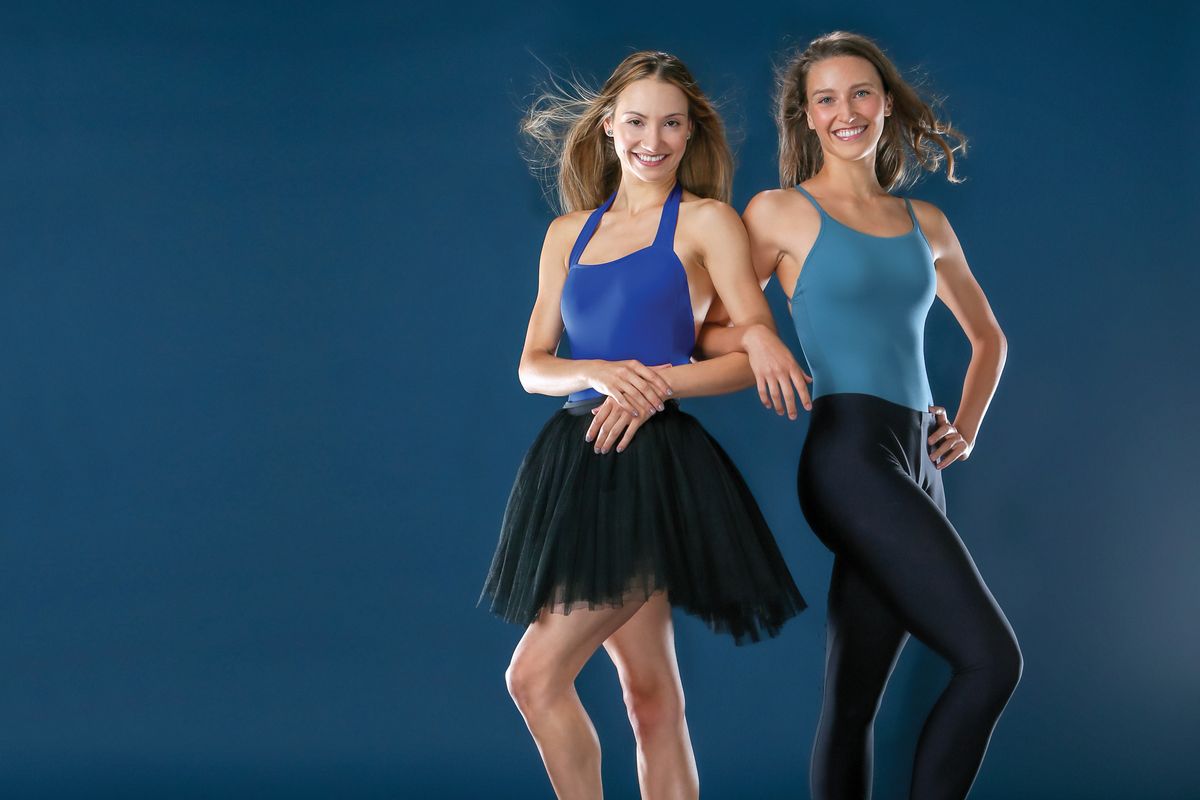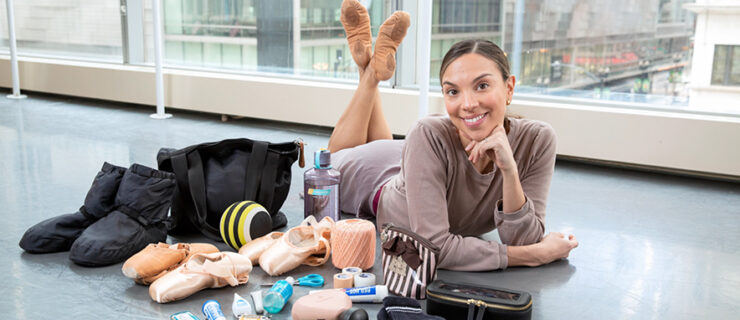Christine Shevchenko and Devon Teuscher: ABT's Dazzling New Generation of Star Power
This is
Pointe‘s December/January 2018 Cover Story. You can subscribe to the magazine here, or click here to purchase this issue.
Christine Shevchenko
and Devon Teuscher have spent practically half their lives with each other. Both dancers joined American Ballet Theatre’s Studio Company in 2006. The following year, they graduated into the main troupe as apprentices, again together. They’ve sat next to each other in every dressing room they’ve ever occupied, and shared hotel rooms on the road. And in September 2017, at the age of 28, they became the company’s two youngest female principal dancers—on the same day. If they weren’t such good friends, they would probably be sick of each other.
It’s particularly remarkable because they’re such different dancers. Shevchenko, who started out in Odessa, Ukraine, as an aspiring rhythmic gymnast, and later studied at The Rock School for Dance Education in Philadelphia, has an amazing facility and an enviably confident demeanor onstage. She sailed through her debut as Kitri in Don Quixote, her first leading role at ABT, as if it were nothing, with soaring jumps and grand battements so limber that it seemed she might bop herself in the head. (She didn’t.) The following week, she was thrown into Le Corsaire after another dancer got injured; same thing. She is as comfortable as Myrtha in Giselle as she is as the bubbly Mademoiselle Marianne Chartreuse in Alexei Ratmansky’s comic ballet Whipped Cream. Her aplomb seems to arise from a mixture of temperament, training—she did lots of competitions—and a fierce work ethic. “She’s one of the hardest workers I’ve ever met,” says Teuscher.

“There’s something similar that drives each of us, but there’s also a way we can stand back and admire what the other one does,” says Teuscher. Jayme Thornton for Pointe.
Teuscher is cut from different cloth. She initially trained at smaller schools in Illinois and Vermont before coming to ABT’s Jacqueline Kennedy Onassis School at the age of 15. Before becoming a principal, she had already begun to specialize in dramatic roles. One of the first times she caught the audience’s attention was in Antony Tudor’s psychological ballet Pillar of Fire, where she played a young woman tormented by insecurity and forbidden desires. Teuscher gave a searing performance, intense but utterly lacking in exaggeration. She is an icy Myrtha in Giselle, a benevolent and glowing Lilac Fairy in The Sleeping Beauty, a tragic, even heroic Nikiya in La Bayadère. (Her nemesis Gamzatti was played by, you guessed it, Shevchenko.) And Ratmansky, ABT’s choreographer in residence, created a unique role for her in his 2016 Serenade after Plato’s Symposium. In this ballet about philosophical dialogue, she was a commanding presence, the only woman among seven men.
I caught up with the two dancers as they were gearing up for the start of ABT’s fall season. Together, they took stock of their first year as principals.
You’ve spent so much of your career side by side, and you’re also friends. Do you think the fact that you’re such different dancers played a part in cementing your friendship?
Devon Teuscher:
We realize how different we are and that we’re going to produce very different results. There’s something similar that drives each of us, but there’s also a way we can stand back and admire what the other one does.
Christine Shevchenko:
Devon lights this spark inside of me. I always admire how cleanly she works. Her technique is so pure. She’s good for me.

Teuscher and Shevchenko as Nikiya and Gamzatti in “La Bayadère.” Rosalie O’Connor, Courtesy ABT.
Was there a big shift for you after you became principal dancers?
DT:
Huge.
CS:
In the corps, you’re sort of protected from your flaws. But now, as a principal, you’re laying everything out there for everyone to see. There’s nothing to shield you. I’m used to people saying “Do this,” or “It should look like this.” Now you have all this freedom to try different things. And it’s about choosing what fits you…
DT:
…which is hard. I remember starting to work on Swan Lake, and my coach, Irina Kolpakova, asked, What do you want to do at this moment? And I was like, What do you mean? You tell me what to do! [laughs]
What has been the hardest thing about being a principal, so far?
CS:
For me it was the intensity of my first Met season as a principal. I was just not prepared for the fact that I would need to put whole full-length ballets together in just a few days. I thought that when you got promoted to principal you’d get all this time to work on each role, really fix everything, all the details. And literally I had less time to put roles together than when I was a soloist.
DT:
We would finish a ballet on Thursday and premiere a new role the following Tuesday or Wednesday. Of course, we had worked on it earlier in the year. You had to really trust yourself and think: I did all that work throughout the year; it’s in there somewhere. You have to be able to pull it out and put it onstage.
Devon Teuscher and Christine Shevchenko: Behind the Scenes with Our Dec/Jan Cover Stars
www.youtube.com
How do you prepare for a big new role?
CS:
I usually start with watching thousands of videos, watching everyone else’s take on that role and figuring out a version that’s suited for me. The most important thing is to find how you want to play a certain role, how each step can say what you want it to say. It’s more than dancing. I’m constantly thinking about what the role means, how to get the character across.
DT:
It can be difficult sometimes. I’ve attempted both starting from the steps and from the dramatic side. When I did Swan Lake, I went directly to Byam Stevens, an acting coach who’s worked with several ABT dancers, before I started any studio rehearsals. We worked up a story about the overarching truths I wanted to get across. Then I went to the studio and worked on the steps and tried to mesh the two. I’ve also done the opposite. For La Bayadère, I didn’t work with Byam at all. It’s such a Russian masterpiece —I wanted to simply go with what Natalia Makarova [who set the ballet] and Irina Kolpakova said and make that work for me.
What feels more exciting to you now, digging into the canon, or having something created on you?
CS:
For me it’s dancing these ballets that I’ve always wanted to do and getting to explore them. They’re all still new to us. And there’s so much work to do, it never ends—the acting and the dancing. It’s about building more and more into each role.
DT:
I feel similarly. We get to make them relevant for us now. When I got promoted to principal I had a rehearsal with Alexei Ratmansky and he gave me great advice. He said that now is the really exciting time because this is when you get to see what you can do, not what someone else wants you to do.

Shevchenko as Kitri in “Don Quixote.” Photo by Gene Schiavone, Courtesy ABT.
Have you had mentors in the company?
DT:
We were lucky to join at the same time, along with Katherine Williams. We really stuck together.
CS:
It was mostly the three of us helping each other navigate things.
DT:
There were a few senior corps girls who gave us advice, but generally we were on our own.
How have things changed now that there are fewer guest stars parachuting in to do lead roles?
DT:
The morale of the company is better because there’s more hope. You can go from apprentice to principal. And you can do all the ballets. Before, you saw all these people coming in and it was like, Well, I don’t know if I’ll ever get to dance that.
CS:
Maybe it’s also this new generation and this new way of working together. I’ve tried to interact more with the younger dancers.
Has the #MeToo movement affected the company’s culture?
CS:
I’ve never had a situation that felt inappropriate to me, so I haven’t felt a huge shift or change. Maybe people talk about it more, but nothing has changed in the way that we work.
DT:
I think we’re lucky. I’ve never experienced something I was uncomfortable with. I think that comes from Kevin McKenzie being such a great director and respectful man. It starts at the top, I think. We do have a Code of Conduct, and we had a meeting and talked about the guidelines.

“As a principal, you’re laying everything out there for everyone to see,” says Shevchenko. “There’s nothing to shield you.” Jayme Thornton for Pointe.

“Those brief moments onstage—it feels like that’s where I’m supposed to be,” says Teuscher. “That’s where I feel most at home.” Jayme Thornton for Pointe.
What’s your relationship to social media?
CS:
I try to post every day. It’s almost a second job. Sometimes it gets in my head, like I should be posting more, getting myself out there, but it takes time and energy. Mentally, it can be exhausting.
DT:
I think it can also become a distraction from the actual work. I can’t tell you how many rehearsals I’ve seen where for the last half hour dancers will be taking photos and videos because they need something to post on their social media instead of using the time to rehearse. I would never want to take away from that time.
Devon, your partner in life is fellow ABT principal
Cory Stearns. What is it like to be in a relationship with someone you work with?
DT:
I remember when we did Swan Lake together earlier this year. We approached it very professionally. It’s interesting because it forces you to stay more invested than you would be normally. It’s not that you don’t care about a regular partner, but there’s so much more care for a person you’re with. I remember him saying that, during the White Swan variation, he was watching from the side as usual, but he was exerting so much more energy because he was so excited about watching and really caring about how I was doing.

Teuscher and Cory Stearns in “Swan Lake.” Photo by Rosalie O’Connor, Courtesy ABT.
How did you and Christine first become friends?
CS:
I remember rooming with you in New Orleans. I think that was the first time we became close.
DT:
She’s very quiet and keeps to herself, so it took a while.
CS:
Yeah, I’m not a talker. When I was a kid, I was really shy.
DT:
And I’m fairly reserved and quiet as well. But Christine is one of the most positive people I’ve met in my life. I love having that around. It makes me a more positive person.
Do you discuss roles?
CS:
We don’t talk so much about roles, we just talk.
What do you love the most about dancing?
CS:
For me, it’s always been about bringing happiness to the people who come to see these stories. It’s about making people happy—I’ve always been a people pleaser. [laughs]
DT:
I think the performing aspect is the thing I love the most. Those brief moments onstage—it feels like that’s where I’m supposed to be. It’s an almost intimate feeling. That’s where I feel most at home.





